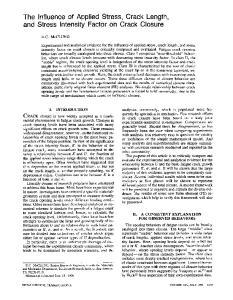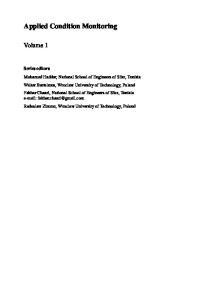The influence of crack length on fatigue crack growth in deep sharp notches
- PDF / 1,262,995 Bytes
- 7 Pages / 594 x 774 pts Page_size
- 66 Downloads / 369 Views
I.
INTRODUCTION
IN a standard fatigue-crack growth test ~ the crack growth rate is determined by the stress intensity range AK and the stress ratio R. 2 In the 1960's and early 1970's it was thought that under the conditions of linear elastic fracture mechanics, these two parameters were sufficient to describe the growth rate for any crack in a given material. In the last few years, however, a number of experimental results 3-24 have shown that short cracks tend to grow faster than long cracks at equal stress intensity range. Typical fatigue crack growth curves are shown schematically in Figure 1. In many cases the growth rate decreases with increasing AK and sometimes the crack even stops altogether. Various mechanisms have been proposed to explain this special behavior of short cracks: (I) In the case of surface microcracks in smooth specimens some authors have reported4']2'17 differences in the deformation behavior between short and long cracks. For a short crack (of crack length smaller than the grain size, especially) the crack tip plasticity (and therefore da/dN) is influenced not only by AK, but also by variou~ microstructure parameters, for example by the grain size and the distance between the crack tip and the next grain boundary. (II) The deviation from an "ideal" mode-I crack can also reduce d a / d N , 25'26'27 because crack deflection and crack branching decrease the local stress intensity range AKj. This mechanism should be especially important for crack lengths in the order of magnitude of a characteristic size of the deflection. (III) Other authors 5-t~176 have argued that crack closure differs for large and small cracks. Crack closure means that the fracture surfaces come into contact before the minimum stress-intensity factor Km~, is reached. The stress intensity where this contact occurs is called the closure stress intensity Kd, and the stress intensity range where no closure occurs is called the effective stress intensity range AKeff (AKeff = Km~x- Kcl, where Kmax is the maximum stressintensity factor). It is usually assumed that da/dN is a R. PIPPAN, Research Assistant, is with Erich-Schmid-Institut fiir Festk6rperphysik der Osterreichischen Akademie der Wissenschaften, Leoben, Austria. M. BERGER, formerly Graduate Student, lnstitut f'tir Metallphysik, Montanuniversitiit.Leoben, Austria, is with Balzers Company, FL-Liechtenstein. H. P. STUWE is Professor, Institut f'tir Metallphysik der Montanuniversitiit Leoben, and Director, Erich-Schmid-Institut fiir Festk6rperphysik der Osterreichischen Akademie der Wissenschafen, Leoben. Austria. Manuscript submitted May 1, 1986. METALLURGICAL TRANSACTIONS A
function only of AKeff. One distinguishes among various mechanisms such as the plastic-,28 the roughness-,6,27 and the oxide closure. 29'3~ Each of these mechanisms depends on different loading parameters and on the history of the crack (and, therefore, also on the length of the crack). Since in a constant-load test AK and the crack length are changed simultaneously, it is difficult to separate th
Data Loading...










